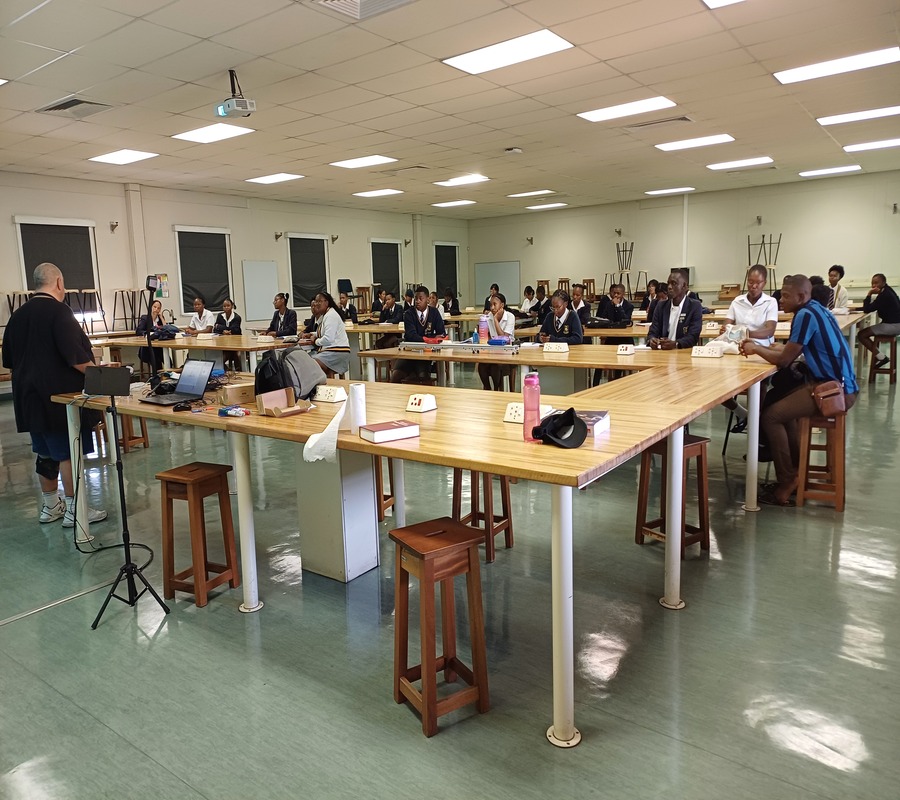
The number of high school learners electing mathematics and physical science as subjects are declining. Reports suggest that from 2015 to 2019, the number of students taking mathematics declined by 16%, while the number of students taking physical science declined by 15%.
The teaching of science principles in a fun and engaging way at a fraction of the cost and with the necessary enthusiasm could inspire more learners and teachers to persevere with the subject.

That is what the University of the Western Cape’s (UWC) Physical Science department has started with a pilot project at Soneike High School in Kuils River.
The school is housed in neatly refurbished shipping containers where there are limited lab facilities.
Senior technical officer and passionate physics lecturer, Ian Schroeder, heads up the initiative, Project 2026.
He says the name signifies the year current participants should be in their first year at varsity and when the results of these efforts will be seen.
Along with UWC doctoral student, Sumeera Gopal, the two conduct voluntary work in the community on Saturdays by teaching science experiments both at the school and at UWC’s science labs.
“Learners in Grade 11 with Physical Science are given access to UWC lab facilities with the aim of exposing them to a real-life lab experience.
We want learners to thrive in their first year and not just to try and survive, the way I had to,” said Schroeder.
Although such early university orientation is not common, Schroeder started the initiative to help learners better prepare for the Physics curriculum by the time they enrolled for their first year at varsity.

“The idea is to help them understand the basics before they reach varsity level. If my efforts can help just a few learners choose a career in Physics and help address the needs of our country, I would find that most encouraging,” he said.
“We have found that by the time learners reach varsity level, our lecturers can easily pick up on the lack of experimental work. With this project, we would like to address this. When it comes to lab work, learners are often hampered by a fixed mindset. To me, it definitely is a mindset issue and not a skills issue.
“It is encouraging, though, that it is a play-as-you-learn type of experience for this year’s Grade 11s who – for the first time this year – experienced the undergraduate Physics lab. It is as if they were first year-varsity students, complete with official access to the UWC student e-learning portal.”
Soneike Secondary teacher, Phumlani Manzini, said there was little to no engagement before. But the learners are now more interested in the subject.
“These experiments are very crucial for understanding the subject. Ian is applying experiential learning and this proves to me that it is the best teaching practice. His technique is to present learners with a problem and allow them to figure it out by themselves,” said Manzini.
Another advantage was that lessons were based on real-life situations and this technique captured the learners’ attention.
“These days their foundation is firmly laid. I notice that whenever I teach a new theory, one can see that learners can easily draw from the practical work they’ve covered with Ian. It is encouraging to see how they are eager to know more about science.”
There is great collaboration among staff in the Physical Sciences Department to drive the project. This includes the efforts of fellow UWC lecturer and SARChI Chair, , whose name has become synonymous with research involving the Square Kilometre Array (SKA).
Prof Maartens provided funding for transport to and from the school to ensure Soneike Secondary learners attended the hands-on experimental sessions at the UWC undergraduate labs.
The project has no funding yet but it is making gigantic strides in helping the learners understand the basics of physics.
“Needless to say, underprivileged schools have limited access to science laboratories, but we succeed in teaching concepts like momentum conservation by using low-priced items. For under R100, we use a tape measure, a soccer ball, tennis ball and one available smartphone per group,” said Schroeder, who is ploughing back his knowledge earned at previous work environments like iThemba LABS and others.
He said the same goes for teaching the principles of Newton’s second law and sliding friction.
“The latter we perform using two rulers, a hardcover book and a jenga block for less than R40 per group – which are all very accessible items. We engage students in hands-on experiments which are the beating heart of science, technology, engineering and mathematics.”
Schroeder believes anyone can understand Physics.
“It is unnecessary for these learners to struggle through their first year the way I did. This is what we want to achieve with Project 2026. “The cost of expensive equipment definitely doesn’t help the experimental cause. We also discovered, based on the Covid lockdown experience, that simulations are simply not good enough to develop authentic experimental skills and the mindset of thinking like a scientist. Learners need live experiments,” he said.
“Project 2026 requires follow-up work. For instance, they have to perform the tennis-soccer ball experiment to see if momentum is conserved in that system. They also have to write reports on both experiments.
“There is involvement and collaboration, while students have their ideas challenged. It is a rewarding environment where they have the space to explore the why, and that excites me.
“Being a reflective practitioner is not only key to education but also to industry, and requires practice.
“All students of Physical Sciences should have this experience – they deserve it. This is the quality education we need for the bright future we envisaged back in the 80s.”
